Analysis of the Effect of Demographic Variables on Lysosomal Enzyme Activities in the Missouri Newborn Screening Program
Abstract
1. Introduction
2. Materials and Methods
2.1. Screening Procedure
2.2. Establishment of Cutoffs
2.3. Analysis Procedures
2.3.1. Gender
2.3.2. Gestational Age
2.3.3. Birthweight
2.3.4. Age at Collection
3. Results
3.1. Distribution Shape
3.2. Calculation of Confidence Intervals
3.3. Gender
3.4. Gestational Age
3.5. Birthweight
3.6. Age at Collection
4. Discussion
4.1. Gender
4.2. Age at Collection
4.3. Relationship Between Birthweight and Age at Collection
4.4. Activity for LBW and VLBW Samples After 14 and 28 Days
5. Conclusions
Author Contributions
Funding
Institutional Review Board Statement
Informed Consent Statement
Data Availability Statement
Conflicts of Interest
References
- Poupětová, H.; Ledvinová, J.; Berná, L.; Dvořáková, L.; Kožich, V.; Elleder, M. The birth prevalence of lysosomal storage disorders in the Czech Republic: Comparison with data in different populations. J. Inherit. Metab. Dis. 2010, 33, 387–396. [Google Scholar] [CrossRef] [PubMed]
- NewSTEPs. Newborn Screening Status for All Disorders. Available online: https://www.newsteps.org/resources/newborn-screening-status-all-disorders (accessed on 28 May 2025).
- Kishnani, P.; Amartino, H.M.; Lindberg, C.; Miller, T.M.; Wilson, A.; Keutzer, J.; Pompe Registry Boards of Advisors. Timing of diagnosis of patients with pompe disease: Data from the pompe registry. Am. J. Med. Genet. Part A 2013, 161, 2431–2443. [Google Scholar] [CrossRef] [PubMed]
- Reisin, R.; Perrin, A.; García-Pavía, P. Time delays in the diagnosis and treatment of Fabry disease. Int. J. Clin. Pract. 2017, 71, e12914. [Google Scholar] [CrossRef] [PubMed]
- Beck, M. Treatment strategies for lysosomal storage disorders. Dev. Med. Child Neurol. 2018, 60, 13–18. [Google Scholar] [CrossRef] [PubMed]
- Hopkins, P.V.; Campbell, C.; Klug, T.; Rogers, S.; Raburn-Miller, J.; Kiesling, J. Lysosomal storage disorder screening implementation: Findings from the first six months of full population pilot testing in Missouri. J. Pediatr. 2015, 166, 172–177. [Google Scholar] [CrossRef] [PubMed]
- Klug, T.L.; Swartz, L.B.; Washburn, J.; Brannen, C.; Kiesling, J.L. Lessons Learned from Pompe Disease Newborn Screening and Follow-up. Int. J. Neonatal Screen. 2020, 6, 11. [Google Scholar] [CrossRef] [PubMed]
- Missouri State Public Health Laboratory. Poor Quality Specimens Delay Detection of Disorders in Newborns. Available online: https://health.mo.gov/lab/newborn/pdf/poor_quality_specimens.pdf (accessed on 18 June 2025).
- Ferré, C.; Callaghan, W.; Olson, C.; Sharma, A.; Barfield, W. Effects of Maternal Age and Age-Specific Preterm Birth Rates on Overall Preterm Birth Rates—United States, 2007 and 2014. MMWR Morb. Mortal. Wkly. Rep. 2016, 65, 1181–1184. [Google Scholar] [CrossRef] [PubMed]
- Martin, J.A.; Hamilton, B.E.; Osterman, M.J.K.; Driscoll, A.K. Births: Final Data for 2018 Figure 1. Number and Rate of Triplet and Higher-Order Multiple Births: United States, 1980–2018. 2019. Available online: https://www.cdc.gov/nchs/products/index.htm (accessed on 18 June 2025).
- Topçu, H.O.; Güzel, A.I.; Özgü, E.; Yıldız, Y.; Erkaya, S.; Uygur, D. Birth weight for gestational age: A reference study in a tertiary referral hospital in the middle region of Turkey. J. Chin. Med. Assoc. 2014, 77, 578–582. [Google Scholar] [CrossRef] [PubMed]
- Oken, E.; Kleinman, K.P.; Rich-Edwards, J.; Gillman, M.W. A nearly continuous measure of birth weight for gestational age using a United States national reference. BMC Pediatr. 2003, 3, 6. [Google Scholar] [CrossRef] [PubMed]
- Hsieh, W.S.; Wu, H.-C.; Jeng, S.-F.; Liao, H.-F.; Su, Y.-N.; Lin, S.-J.; Hsieh, C.-J.; Chen, P.-C. Nationwide singleton birth weight percentiles by gestational age in Taiwan, 1998–2002. Acta Paediatr. Taiwanica 2006, 47, 25–33. [Google Scholar]
- Roberts, C.L.; Lancaster, P.A.L. Australian national birthweight percentiles by gestational age. Med. J. Aust. 1999, 170, 114–118. [Google Scholar] [CrossRef]
- Supriya, M.; De, T.; Christopher, R. Age and gender-specific reference intervals for lysosomal enzymes in dried blood spot samples: A study in Indian population. Clin. Biochem. 2017, 50, 858–863. [Google Scholar] [CrossRef]
- Chen, X.; Qiu, W.; Ye, J.; Han, L.; Gu, X.; Zhang, H. Demographic characteristics and distribution of lysosomal storage disorder subtypes in Eastern China. J. Hum. Genet. 2016, 61, 345–349. [Google Scholar] [CrossRef]
- Rules of Department of Health and Senior Services. Division 25—Missouri State Public Health Laboratory. Chapter 36—Testing for Metabolic Diseases. 2019. Available online: https://s1.sos.mo.gov/cmsimages/adrules/csr/current/19csr/19c25-36.pdf (accessed on 18 June 2025).
- Missouri Guidelines for Newborn Screening Specimens from Premature, Low Birth Weight, Sick or NICU Infants. Available online: https://health.mo.gov/lab/newborn/pdf/nicuguidelinesandkeyfornbs.pdf (accessed on 18 June 2025).
- Washburn, J.; Millington, D.S. Digital Microfluidics in Newborn Screening for Mucopolysaccharidoses: A Progress Report. Int. J. Neonatal Screen. 2020, 6, 78. [Google Scholar] [CrossRef] [PubMed]
- Hopkins, P.V.; Klug, T.; Vermette, L.; Raburn-Miller, J.; Kiesling, J.; Rogers, S. Incidence of 4 Lysosomal Storage Disorders From 4 Years of Newborn Screening. JAMA Pediatr. 2018, 172, 696–697. [Google Scholar] [CrossRef] [PubMed]
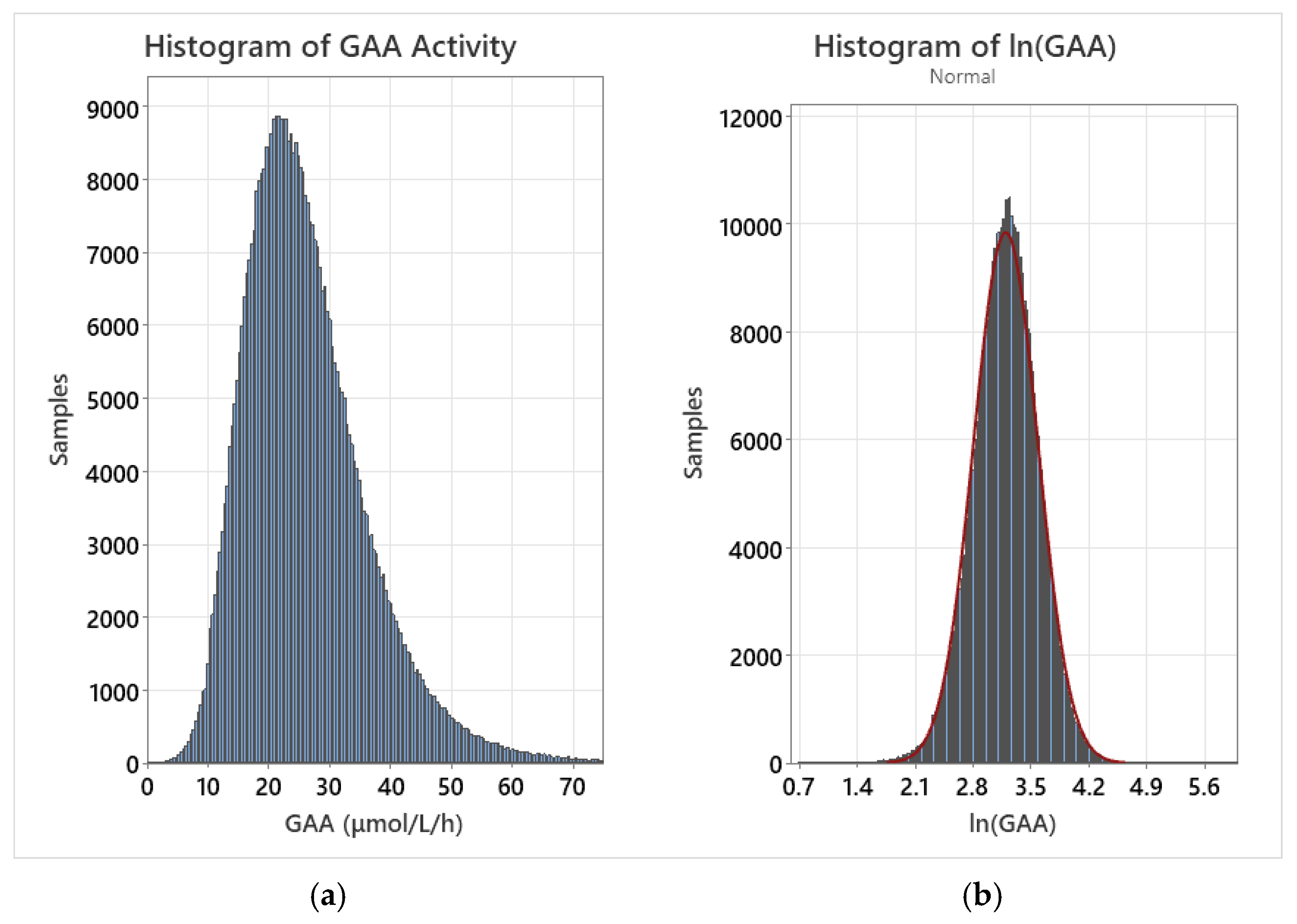
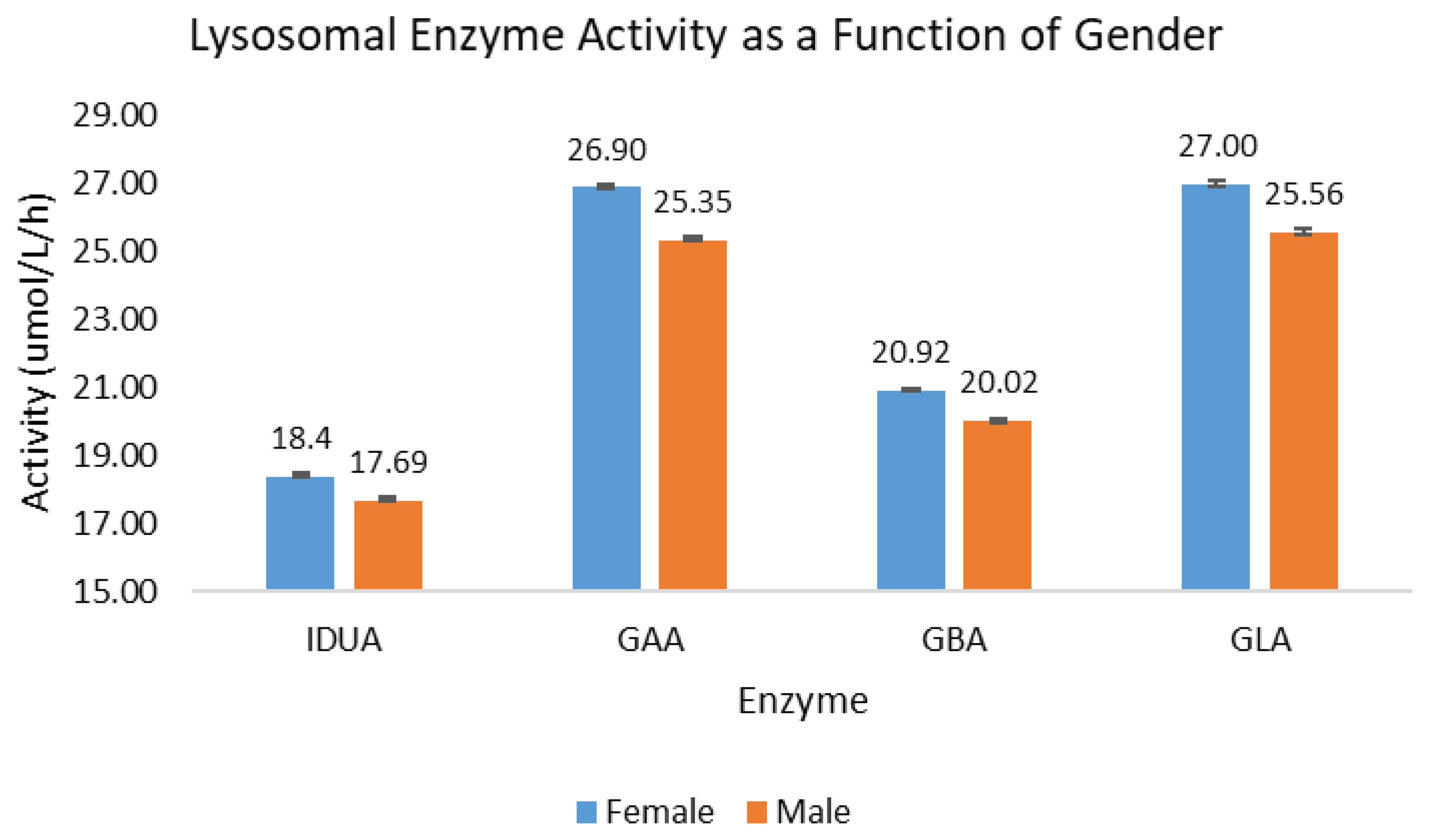
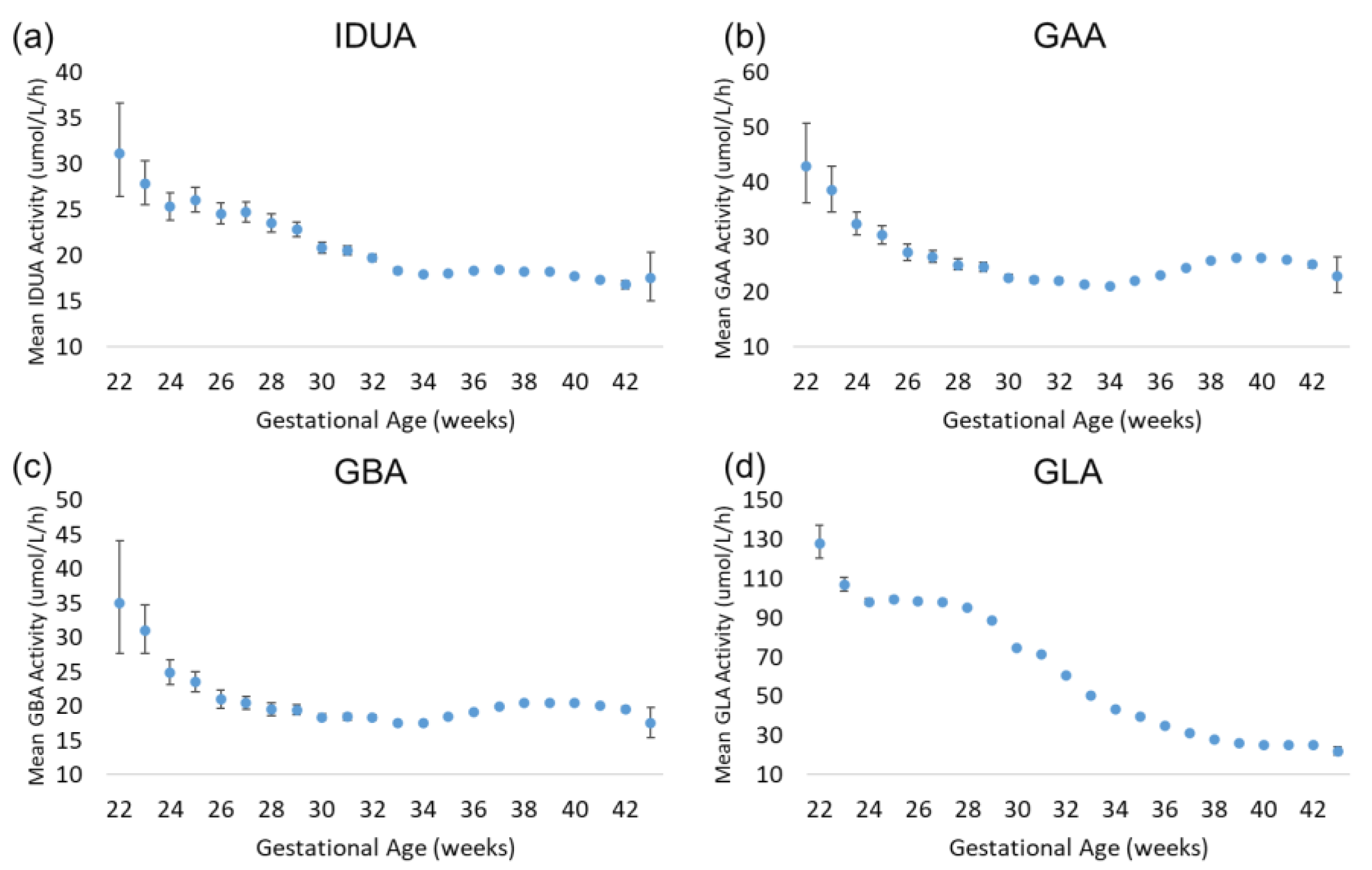
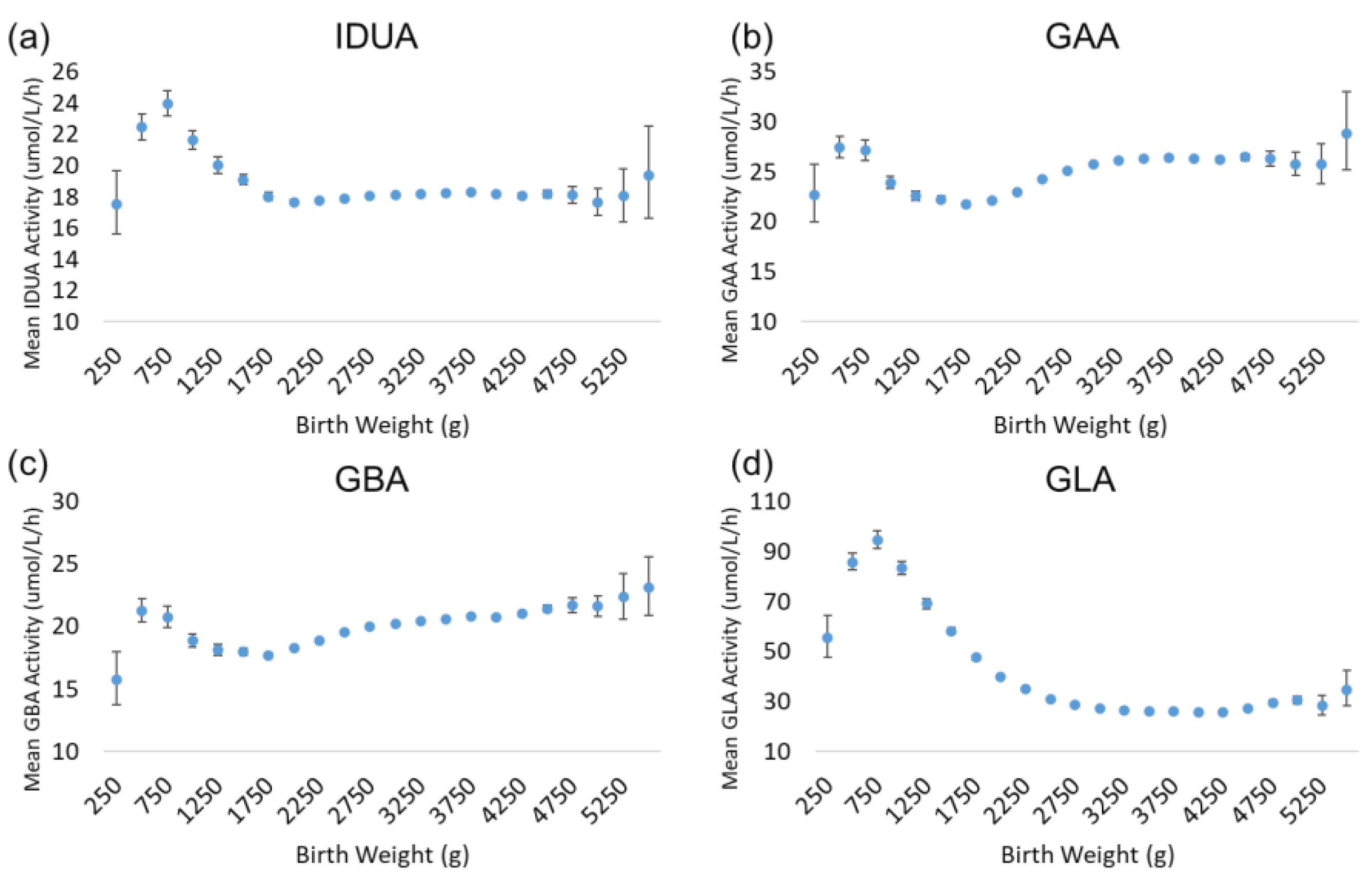


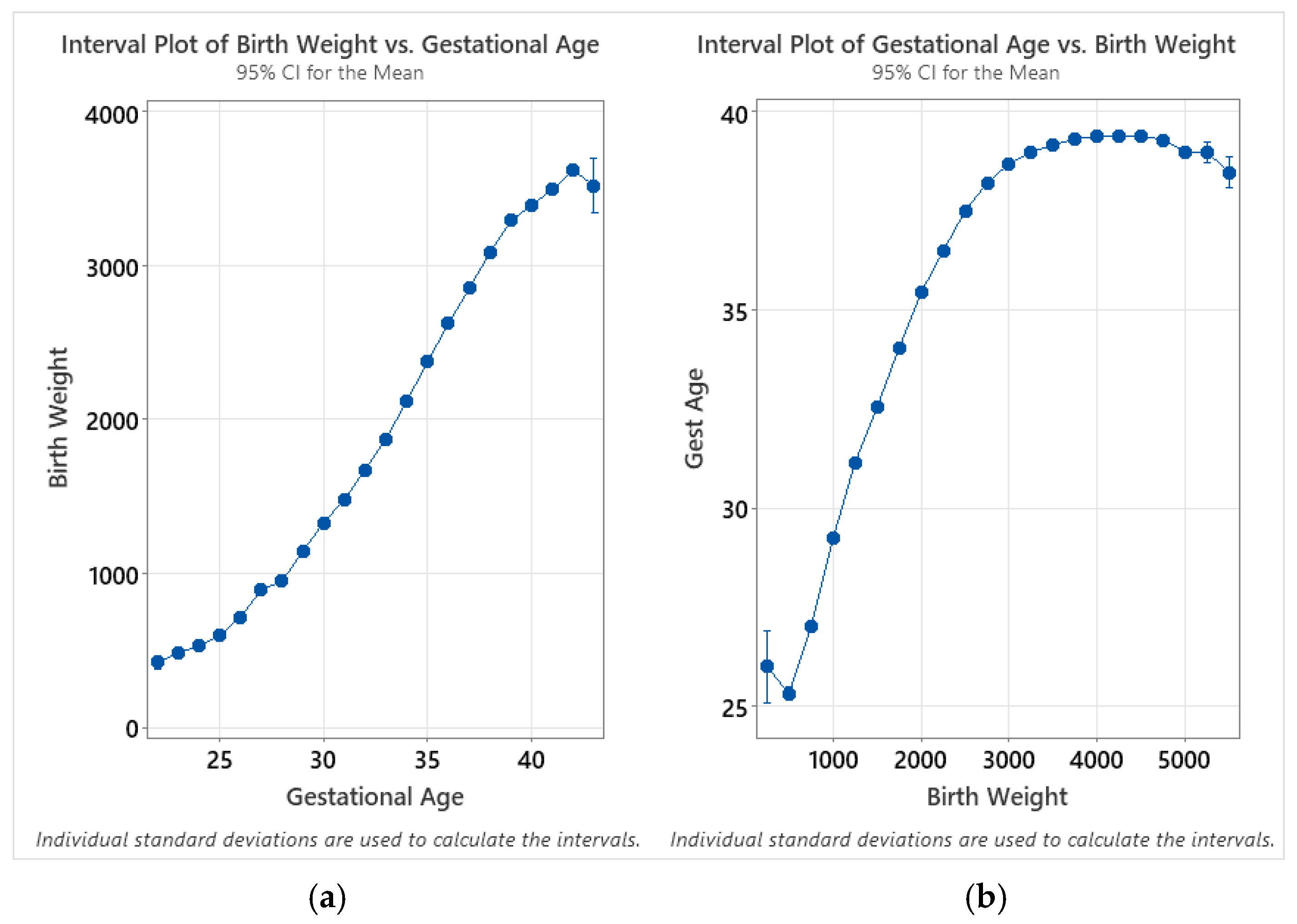

Disclaimer/Publisher’s Note: The statements, opinions and data contained in all publications are solely those of the individual author(s) and contributor(s) and not of MDPI and/or the editor(s). MDPI and/or the editor(s) disclaim responsibility for any injury to people or property resulting from any ideas, methods, instructions or products referred to in the content. |
© 2025 by the authors. Published by MDPI on behalf of the International Society for Neonatal Screening. Licensee MDPI, Basel, Switzerland. This article is an open access article distributed under the terms and conditions of the Creative Commons Attribution (CC BY) license (https://creativecommons.org/licenses/by/4.0/).
Share and Cite
Vermette, L.; Washburn, J.; Klug, T. Analysis of the Effect of Demographic Variables on Lysosomal Enzyme Activities in the Missouri Newborn Screening Program. Int. J. Neonatal Screen. 2025, 11, 48. https://doi.org/10.3390/ijns11020048
Vermette L, Washburn J, Klug T. Analysis of the Effect of Demographic Variables on Lysosomal Enzyme Activities in the Missouri Newborn Screening Program. International Journal of Neonatal Screening. 2025; 11(2):48. https://doi.org/10.3390/ijns11020048
Chicago/Turabian StyleVermette, Lacey, Jon Washburn, and Tracy Klug. 2025. "Analysis of the Effect of Demographic Variables on Lysosomal Enzyme Activities in the Missouri Newborn Screening Program" International Journal of Neonatal Screening 11, no. 2: 48. https://doi.org/10.3390/ijns11020048
APA StyleVermette, L., Washburn, J., & Klug, T. (2025). Analysis of the Effect of Demographic Variables on Lysosomal Enzyme Activities in the Missouri Newborn Screening Program. International Journal of Neonatal Screening, 11(2), 48. https://doi.org/10.3390/ijns11020048





